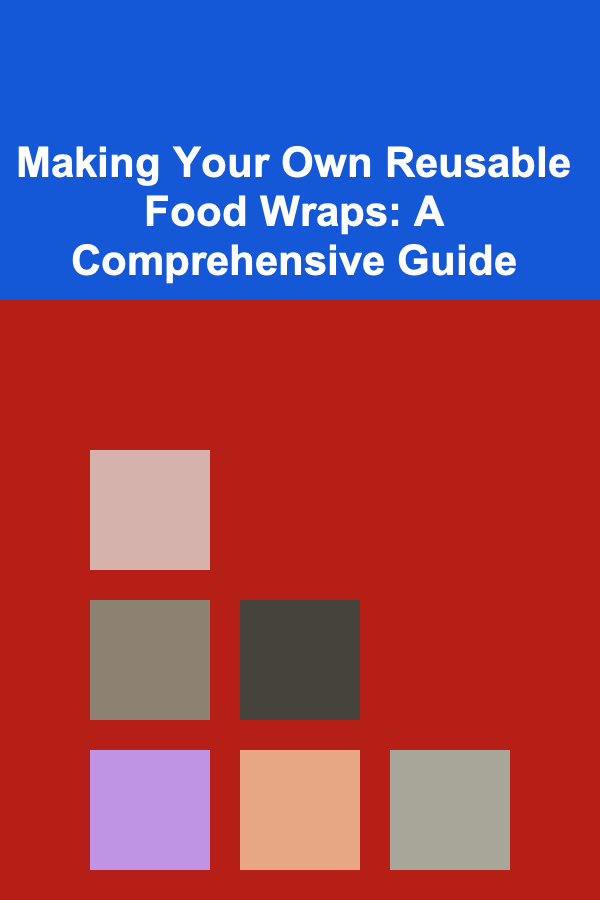
Making Your Own Reusable Food Wraps: A Comprehensive Guide
ebook include PDF & Audio bundle (Micro Guide)
$12.99$5.99
Limited Time Offer! Order within the next:

In a world increasingly conscious of its environmental impact, reducing single-use plastics has become a paramount concern. One simple, yet powerful, step towards a more sustainable lifestyle is replacing plastic cling wrap with reusable food wraps. These wraps, typically made from fabric coated with beeswax, plant-based waxes, or a combination of resins and oils, offer a versatile and eco-friendly alternative for food storage. This comprehensive guide will walk you through the process of creating your own reusable food wraps, exploring different wax blends, techniques, and troubleshooting tips to ensure your success.
Why Make Your Own Reusable Food Wraps?
While commercially available reusable wraps are convenient, crafting your own offers several compelling advantages:
- Cost-Effectiveness: DIY wraps are significantly cheaper than purchasing pre-made options, especially if you already have some of the materials on hand.
- Customization: You have complete control over the size, shape, and fabric patterns of your wraps, allowing you to create wraps perfectly suited to your needs. Imagine wraps shaped specifically for covering odd-sized bowls or wrapping uniquely shaped fruits and vegetables.
- Material Selection: You can choose organic cotton, linen, or other sustainable fabrics and select beeswax from ethical sources, ensuring that your wraps align with your values. This also allows you to control the ingredients and avoid potential allergens or unwanted additives found in some commercial products.
- Reduced Waste: Making your own wraps reduces your reliance on single-use plastics and minimizes packaging waste associated with commercially produced alternatives. You are actively contributing to a circular economy by reusing materials and reducing landfill contributions.
- A Fun and Rewarding Project: Making reusable food wraps is a satisfying and creative DIY project that can be enjoyed by individuals, families, or even as part of a community workshop. It's a tangible way to connect with sustainable practices and share the benefits with others.
Materials You'll Need
Gathering the right materials is the first step towards creating successful reusable food wraps. The core components are fabric, a coating agent (typically wax or a wax blend), and a heat source.
Fabric Selection
Choosing the right fabric is crucial for the durability and effectiveness of your wraps. Here are some key considerations:
- Natural Fibers: Opt for natural, breathable fabrics like cotton, linen, or hemp. These fabrics are absorbent, allowing the wax mixture to penetrate effectively.
- Tight Weave: Select a fabric with a tight weave. This will prevent the wax from seeping through too quickly and ensure a more durable and waterproof wrap. Quilting cotton is a popular choice.
- Organic Options: If sustainability is a priority, choose organic cotton or hemp. This ensures that the fabric was grown without harmful pesticides or herbicides.
- Pre-Washing: Always pre-wash and dry your fabric before waxing. This will remove any sizing or finishes that might interfere with the wax adhesion and prevent shrinkage after the wraps are made.
- Print and Design: Have fun with your fabric choices! Select patterns and colors that you love. Consider using scraps of fabric you already have on hand to further reduce waste.
- Avoid Synthetic Fabrics: Avoid synthetic fabrics like polyester or nylon. These fabrics do not absorb wax well and can melt or be damaged by the heat used in the waxing process.
Coating Agents: Exploring Wax Options and Blends
The coating agent is what gives your wraps their stickiness and ability to mold around food containers. There are several options available, each with its own properties and benefits:
Beeswax
Beeswax is the most traditional and widely used coating agent. It provides excellent tackiness and a pleasant, natural scent.
- Source: Ensure that your beeswax is sourced from ethical and sustainable beekeeping practices. Look for local beekeepers or suppliers who prioritize bee health and welfare.
- Types: Beeswax comes in different forms, including blocks, pellets, and grated. Pellets are often the easiest to work with.
- Properties: Beeswax is naturally antimicrobial and water-resistant, making it an excellent choice for food preservation. It provides a good balance of tackiness and flexibility.
- Drawbacks: Beeswax can be slightly brittle and prone to cracking, especially when used alone. It is also not vegan-friendly.
Plant-Based Waxes (Vegan Options)
For a vegan alternative, consider using plant-based waxes like candelilla wax or soy wax.
- Candelilla Wax: Derived from the candelilla plant, this wax is harder and more brittle than beeswax, so it's best used in a blend. It provides a good shine and hardness to the wraps.
- Soy Wax: Made from soybean oil, soy wax is a softer wax that requires a higher percentage of resin to achieve adequate tackiness. It is a renewable resource and a good option for those with sensitivities to beeswax.
Tree Resin (Rosin)
Tree resin, also known as rosin, is a natural resin extracted from pine trees. It adds tackiness and adhesion to the wax blend.
- Properties: Resin is very sticky and helps the wraps adhere to themselves and to containers. It also adds flexibility and prevents the wax from cracking.
- Forms: Resin is available in powdered or granular form. Powdered resin is easier to melt and incorporate into the wax blend.
- Considerations: Use caution when handling resin, as it can be sticky and messy. Avoid inhaling the fumes when melting resin.
Jojoba Oil or Coconut Oil
Adding a small amount of jojoba oil or coconut oil can improve the flexibility and pliability of the wraps.
- Properties: These oils help to soften the wax blend and make the wraps easier to mold and shape. They also add a pleasant scent.
- Considerations: Use only a small amount of oil, as too much can make the wraps greasy.
Recommended Wax Blend Recipes
Experimenting with different wax blends is key to finding the perfect combination for your needs. Here are a few popular recipes to get you started:
- Classic Beeswax Blend: 1 part beeswax, 1/4 part tree resin, 1/8 part jojoba oil (by weight)
- Vegan Blend: 1 part candelilla wax, 1 part tree resin, 1/8 part coconut oil (by weight)
- Simple Beeswax Blend: 3 parts beeswax, 1 part tree resin (by weight)
Note: These are starting points. Adjust the ratios based on your preferences. More resin equals stickier wraps. More oil makes them more pliable, but can also make them greasy if you add too much.
Other Essential Tools
In addition to fabric and wax, you'll need a few other tools to complete the project:
- Double Boiler or Heat-Safe Bowl and Saucepan: Used for melting the wax blend safely and evenly. A double boiler prevents the wax from overheating and scorching.
- Heat-Resistant Spatula or Spoon: For stirring the wax blend as it melts.
- Baking Sheet Lined with Parchment Paper: To protect your work surface and prevent the wraps from sticking.
- Paintbrush or Foam Brush: For applying the wax blend to the fabric. Choose a brush with natural bristles or a foam brush that is heat-resistant.
- Scissors or Rotary Cutter: For cutting the fabric into desired shapes and sizes.
- Iron and Ironing Board (Optional): Can be used to further distribute the wax evenly, especially if you don't have access to an oven.
- Oven (Optional): Can be used to melt the wax into the fabric.
- Clothespins or Clips: For hanging the wraps to dry.
- Kitchen Scale: For accurately measuring the wax blend ingredients (highly recommended for consistent results).
Step-by-Step Instructions: Making Your Own Reusable Food Wraps
Now that you have gathered your materials, let's move on to the step-by-step process of creating your reusable food wraps.
- Prepare Your Fabric: Wash and dry your fabric to remove any sizing or finishes. Cut the fabric into desired shapes and sizes. Common sizes include:
- Small: 7x7 inches (for covering small bowls or wrapping small items)
- Medium: 10x10 inches (for covering medium bowls or wrapping sandwiches)
- Large: 13x13 inches (for covering large bowls or wrapping larger items)
- Prepare the Wax Blend: Combine your chosen wax blend ingredients in a double boiler or heat-safe bowl set over a simmering pot of water. Heat gently, stirring occasionally, until the wax is completely melted and smooth. Be careful not to overheat the wax, as it can become flammable.
- Apply the Wax to the Fabric (Method 1: Oven):
- Preheat your oven to a low temperature (around 170-200°F or 75-95°C).
- Lay a piece of parchment paper on a baking sheet.
- Place a fabric square on the parchment paper.
- Using a paintbrush or foam brush, evenly coat the fabric with the melted wax blend. Ensure that the entire surface of the fabric is covered, but avoid applying too much wax, as this can make the wraps stiff and greasy.
- Place the baking sheet in the preheated oven for 3-5 minutes, or until the wax is evenly melted and absorbed into the fabric.
- Remove the baking sheet from the oven and carefully peel the waxed fabric off the parchment paper.
- If there are any areas that are not fully coated, brush on more wax and return the baking sheet to the oven for another minute or two.
- Apply the Wax to the Fabric (Method 2: Iron):
- Lay a piece of parchment paper on your ironing board.
- Place a fabric square on the parchment paper.
- Using a paintbrush or foam brush, evenly coat the fabric with the melted wax blend. Ensure that the entire surface of the fabric is covered, but avoid applying too much wax, as this can make the wraps stiff and greasy.
- Cover the waxed fabric with another piece of parchment paper.
- Using a medium heat setting (no steam), iron over the parchment paper, moving the iron slowly and evenly. The heat from the iron will melt the wax and distribute it throughout the fabric.
- Continue ironing until the wax is evenly distributed and the fabric is fully saturated.
- Remove the top piece of parchment paper and carefully peel the waxed fabric off the bottom piece of parchment paper.
- If there are any areas that are not fully coated, brush on more wax and repeat the ironing process.
- Air Dry the Wraps: Immediately after removing the waxed fabric from the oven or ironing board, hang it to dry using clothespins or clips. This will allow the wax to cool and harden properly. Avoid laying the wraps flat to dry, as this can cause them to stick to the surface. Drying time will vary depending on the humidity and temperature, but typically takes around 15-30 minutes.
- Inspect and Trim: Once the wraps are completely dry, inspect them for any uneven areas or excess wax. Trim any frayed edges or drips of wax with scissors.
- Test and Enjoy: Your reusable food wraps are now ready to use! Test them out by wrapping a sandwich, covering a bowl, or wrapping a piece of fruit. The warmth of your hands will help the wraps to mold and adhere to themselves and to the container.
Care and Maintenance of Your Reusable Food Wraps
Proper care and maintenance will significantly extend the lifespan of your reusable food wraps.
- Washing: Wash your wraps with cool water and a mild dish soap. Avoid using hot water or harsh detergents, as these can strip away the wax coating. Gently scrub the wraps with a soft cloth or sponge.
- Drying: Air dry your wraps after washing. Avoid putting them in the dryer, as the heat can melt the wax.
- Storage: Store your wraps in a cool, dry place. You can fold them, roll them up, or store them flat in a drawer or container.
- Avoid Heat: Do not use your wraps in the microwave, oven, or dishwasher. Avoid wrapping hot foods, as this can melt the wax.
- Refreshing: Over time, the wax coating on your wraps may wear down. You can refresh your wraps by repeating the waxing process. Simply melt a small amount of wax blend and apply it to the worn areas. Place the wraps in the oven or use an iron to redistribute the wax.
- Lifespan: With proper care, your reusable food wraps can last for several months to a year or more. When they are no longer usable, you can compost them (if made with natural fibers and beeswax) or cut them into strips and use them as fire starters.
- Food Safety: These wraps are not intended for use with raw meat. If you do use it with raw meat, ensure to wash it separately with hot soapy water.
Troubleshooting Tips
Even with careful preparation, you may encounter some challenges when making your reusable food wraps. Here are some common issues and solutions:
- Wraps are too Stiff: This can be caused by using too much wax or not enough oil. To fix this, try adding a small amount of jojoba oil or coconut oil to the wax blend and re-melting the wraps.
- Wraps are too Greasy: This can be caused by using too much oil. To fix this, try blotting the wraps with paper towels to remove excess oil. You can also try re-melting the wraps and adding a small amount of beeswax or candelilla wax to the blend.
- Wax is Not Adhering to the Fabric: This can be caused by using a fabric with a loose weave or by not pre-washing the fabric. To fix this, try using a fabric with a tighter weave or re-washing the fabric. You can also try adding more resin to the wax blend.
- Wraps are Cracking: This can be caused by using too much beeswax or not enough resin. To fix this, try adding more resin to the wax blend and re-melting the wraps.
- Uneven Wax Coating: Ensure even coating by using a good quality paintbrush and spreading the wax carefully. If using the oven, ensure the heat is evenly distributed. If using an iron, move the iron slowly and evenly.
- Fumes from Melting Wax: Work in a well-ventilated area when melting wax and resin. Use a double boiler to prevent overheating and burning.
Beyond the Basics: Creative Ideas and Variations
Once you've mastered the basic techniques, you can experiment with different variations and creative ideas to personalize your reusable food wraps:
- Infused Wraps: Add a few drops of essential oils (like lavender or lemon) to the wax blend for a subtle, pleasant scent.
- Custom Shapes and Sizes: Create wraps in unique shapes and sizes to fit specific containers or food items.
- Decorative Edges: Use pinking shears to create decorative edges on your fabric before waxing.
- Patchwork Wraps: Combine scraps of different fabrics to create colorful and unique patchwork wraps.
- DIY Kits: Assemble DIY reusable food wrap kits as gifts for friends and family. Include pre-cut fabric, wax blend ingredients, and instructions.
Conclusion: Embracing Sustainable Food Storage
Making your own reusable food wraps is a simple yet impactful way to reduce your environmental footprint and embrace a more sustainable lifestyle. By choosing natural materials, experimenting with wax blends, and following proper care and maintenance practices, you can create durable, versatile, and eco-friendly alternatives to plastic cling wrap. So, gather your materials, get creative, and start making your own reusable food wraps today! You'll be amazed at how easy and rewarding it is to contribute to a healthier planet, one wrap at a time. Beyond the environmental benefits, you'll also discover the satisfaction of creating something useful and beautiful with your own hands. Embrace the journey and enjoy the fruits (and vegetables!) of your labor, wrapped in your very own sustainable creations.
Reading More From Our Other Websites
- [Personal Care Tips 101] How to Choose the Best Makeup Primer for Makeup Artists
- [Personal Care Tips 101] How to Use Deodorant for Sensitive Underarms
- [Home Budget 101] How to Find Discounts on Home Essentials Without Compromising Quality
- [Home Security 101] How to Choose and Install Keyless Entry Systems for Your Home
- [Home Soundproofing 101] How to Soundproof a Basement Home Gym
- [Home Rental Property 101] How to Manage Rental Property During the Off-Season
- [Personal Investment 101] How to Build a Deep Learning-Based Passive Income Business
- [Home Pet Care 101] How to Teach a Cat to Use a Scratching Post
- [Personal Care Tips 101] How to Choose the Right Makeup Primer for Your Skin Type
- [Simple Life Tip 101] Best Declutter‑Free Wardrobe Essentials for a Stress‑Free Simple Lifestyle

10 Easy Ways for Saving on Household Cleaning Products
Read More
How to Curate a Minimalist Lifestyle in a Small Space
Read More
How to Play Story-Driven Games for Emotional Impact
Read More
Reducing Demand for Illegal Wildlife Products: A Deep Dive
Read More
How to Choose the Right Golf Club for Your Handicap
Read More
How to Plan a Themed Board Game Night Checklist
Read MoreOther Products

10 Easy Ways for Saving on Household Cleaning Products
Read More
How to Curate a Minimalist Lifestyle in a Small Space
Read More
How to Play Story-Driven Games for Emotional Impact
Read More
Reducing Demand for Illegal Wildlife Products: A Deep Dive
Read More
How to Choose the Right Golf Club for Your Handicap
Read More